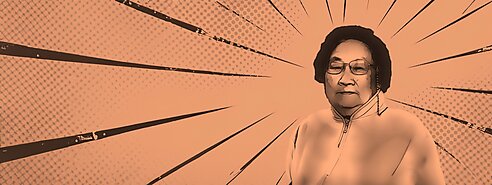- Malaria is a disease spread by mosquitoes. Symptoms usually appear 10–15 days after being bitten and include high fever, tiredness, vomiting, headaches, and in severe cases, coma and death. Malaria has killed millions of humans throughout history and still takes the lives of over 600,000 people every year.
Did you know that malaria used to be endemic to the United States? Until the early 1950s, it killed thousands of Americans every year. But now, malaria has been completely wiped out in the United States. How did this happen?
To learn how malaria was eliminated in this country, watch this video.
Then with partners, in small groups, or as a whole class, respond to the following questions: Why do many people assume that malaria only affects people in hot, tropical areas?- What is the traditional medicine used to prevent and treat malaria? What is the plant source for that medicine?
- What were some of the ways that the U.S. government used to eradicate malaria?
- Why do most people now believe that the methods used in the United States should not be duplicated in other countries?
- Mosquitoes are called “disease vectors” because they can carry malaria, zika, and dengue—all potentially fatal for humans. How much do you know about how mosquitoes bite and transmit disease?
After watching this video, you will know more than you probably ever wanted to. After watching, with partners, in small groups, or as a whole class, respond to the following questions:- Why do female mosquitoes need blood?
- How much water do mosquitoes need in order to lay their eggs?
- In your own words, describe the process by which a mosquito sucks blood.
- Why does the mosquito excrete water as it’s sucking blood?
- What are some effective ways you know of to prevent mosquito bites and the spread of diseases caused by them?
Tu Youyou’s discovery of artemisinin was “arguably the most important pharmaceutical intervention in the last half [of the 20th] century.”
You may have never heard of Tu Youyou, but through her innovative research on antimalarial medicines, Tu’s work has saved millions of lives. In this article, Alexander C. R. Hammond explains how Tu Youyou’s discovery of artemisinin was “arguably the most important pharmaceutical intervention in the last half [of the 20th] century.” The discovery is all the more interesting because of the unusual way she came upon it. Tu and her team combed through ancient Chinese medical texts and painstakingly experimented on plants and herbs recommended by Chinese doctors over 1,600 years ago.
Warm‐Up
Questions for Reading, Writing, and Discussion
Read the article, then answer the following questions:
- The article mentions the Chinese “Cultural Revolution” and how it stymied the career of Tu’s husband. Use your knowledge of history. What was the Cultural Revolution? Why did it come about? What were its outcomes?
- In your own words, describe the sequence of events that led Tu to discover the use of sweet wormwood to treat malaria.
- For which specific discovery was Tu awarded the Nobel Prize?
Extension Activity/Homework
- What do you think?
Using the gene‐editing technology called CRISPR, scientists have been able to genetically modify the species of mosquito that carries malaria. This is not science fiction; the modified mosquitoes already exist in a lab. The question is: Should we use them? What do you think?
- CRISPR technology is only about 10 years old. We don’t know the ramifications of using this tech to alter wild populations of mosquitoes. At the same time, hundreds of thousands of people die each year from malaria. Is it moral not to use this technology?
Watch this video to learn more about this issue.
- After watching the video, write a short opinion essay answering this question:
Should we release genetically modified mosquitoes into the wild to stop malaria? Why or why not?
Remember, an opinion essay is a piece of writing that presents your point of view on a particular subject supported by reasoning and evidence. Make sure you provide at least one counterargument and explain why the other side’s argument is invalid. - Write an autobiographical piece.
The article tells how Tu Youyou contracted tuberculosis when she was 15 and had to leave school for two years. When she was able to resume her education, her experience with serious illness inspired her to learn how to fight diseases like the one that had affected her.
Determination and resilience in the face of adversity are recurrent themes in history. There are many famous examples of historical figures that learned how to overcome obstacles and became stronger as a result.
Think of a challenging problem that you have conquered in your life. It can be a physical or mental ailment, an emotional affliction, or even a hard‐to‐deal with person that you had to learn to work with to get a job done. Write a short essay about the challenge and how you overcame it. Discuss who or what motivated you to solve the problem and the methods you used. - Research a “neglected tropical disease.”
In 2021, the journal Nature published an article about “neglected tropical diseases” (NTDs). The article explains, “The term refers to diseases that have historically been overlooked by the research community. Worldwide, NTDs affected more than 2 billion people in 2013.”
The National Institutes of Health (NIH) says, “Neglected tropical diseases (NTDs), such as dengue, lymphatic filariasis, trachoma, and leishmaniasis, are called ‘neglected,’ because they generally afflict the world’s poor and historically have not received as much attention as other diseases.”
Create a Google Slides presentation or PowerPoint about an NTD. Choose one NTD from this NIH list. In your presentation, provide the following information on the NTD:
- Diagnosis
- Transmission
- Symptoms
- Treatment
- Prevention
Be sure to include photos, videos, maps, charts, and/or other media that will make your presentation engaging for the learner.
